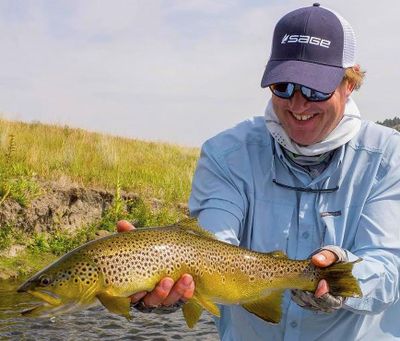Missouri River fly fishing guide still a student of the river after 25 years

Mark Raisler has learned a few things about catching trout in the Missouri River in the 25 years he’s been fishing there.
Come with dry hopes, he tells his clients, but prepare to fish wet.
“Of the 275,000 flies we sell through our shop in a year, only 25,000 are dry,” he said in a winter program for the Inland Empire Fly Fishing Club. Wet flies and nymphs are lost more often than dries, but the statistic still speaks for itself, he said.
In 2008, Raisler opened Headhunters Fly Shop in Craig, Montana, with optimism blind to the odds. “Craig had a population of 35 and there were already two fly shops,” he said.
Shamelessly describing himself as a ski bum turned trout bum, Raisler produces a Headhunters blog with copious servings of trout porn, updates, tips and advice attracting thousands of reads a day by anglers around the globe. “There’s a lot of interest in this fishery,” he said. “It’s world-class.”
His observations – 5,100 articles over nine years – are worth reading even though Raisler contends he’s still “on the learning curve” of fishing the Missouri after logging “only” 3,549 days on the river downstream from Holter Dam.
Spokane anglers visit the Missouri in a steady stream almost year around. With stretches holding up to 3,500 catchable rainbows and 500 brown trout per mile, the fishery can be well worth the 700-mile round trip. One stretch surveyed held 2,700 trout per mile with 50 percent of them being greater than 18 inches, he said.
This bounty has not been a secret. Increasing pressure on the river has challenged guides and freelance fishermen alike to find angles for fishing in a parade of drift boats.
“You have to learn how to compete,” he said. “Sometimes that means rowing past the first rising fish of the day.”
Creel surveys indicate that 98 percent of the Missouri’s fish are in the center of the river, Raisler said.
“Of course there are fish on shore, too, but only if the food source is there. Otherwise, I fish the middle.”
Regardless of which river an angler is on, efficiency catches more fish, he said. That means preparing before leaving for the river and adhering to a system that works.
Cleaning your fly line is one example. “I clean mine four or five times a day,” he said. “The line is the vehicle that delivers your fly to the trout. It’s important.”
He rigs leaders in advance according to a proven formula for dry flies: at least 12-feet long, 60 percent butt, 20 percent taper and 20 percent tippet.
“If the line piles up a little bit, that’s OK,” he said.
Above all, arrive with an abundance of patience.
Studies show that trout on the Missouri might be rising to a feed trough of 180,000 insects per square meter, he said. “It’s not like a freestone stream,” he explained. “Fish in the Missouri can refuse your fly because they don’t have to eat it.”
Some situations dictate a “watch, learn, wait” approach. Give time to prepare for the first cast to a run or rising fish. “That’s when you have the element of surprise in your favor.”
In some cases it’s best to make the first cast short of the fish as a preparation for the next cast – the perfect cast – to a rising fish, he said. “Cast short to learn something without spooking the fish,” he said.
Every guide and fly shop owner has a litany of recommended flies, and Raisler is no exception. He listed many to the intently listening fly club members. Different times of year and different situations dictate selections ranging from tiny soft hackles to husky streamers.
He highlighted parachute flies as being essential and pegged LaFontaine’s Buzzball as his favorite pattern.
“I’m not a match-the-hatch guy,” he said. “I’m a presentation guy. Trout will take a piece of ham if they’ve been eating turkey all day.”
He left the anglers with some homework before they head out on their next fly fishing trip to the Missouri or any other river.
“Practice casting a minimum of 10 minutes a week,” he said. “Fishing isn’t practice; it’s the game.”
The best at any sport take it to another level. Nigel Williams-Goss didn’t become Gonzaga’s leading free-throw shooter by waiting for games to work on his shots from the line.
“I’ve practiced casting virtually every day for 25 years,” Raisler said, noting that the top guides he knows have rods rigged up for a few casts every day, even in winter.
“Pro basketball players who make $36 million a year do dribbling drills,” he said. “Attention to fundamentals is critical in any sport.”